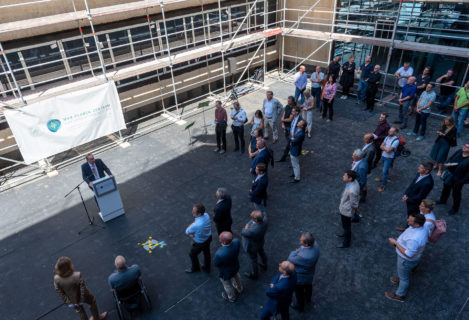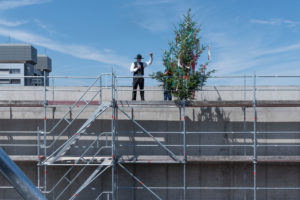Max Planck Center for Physics and Medicine celebrates topping out ceremony

Connecting physics and medicine
Another milestone in the construction of the interdisciplinary center in Erlangen has been achieved. Bavarian Minister of Economic Affairs, Hubert Aiwanger, commended the project for creating an ideal research environment at the topping out ceremony for the Max Planck Center for Physics and Medicine (MPZPM). The Center is a joint institution of the Max Planck Institute for the Physics of Light (MPL), FAU and Universitätsklinikum Erlangen.
“Physics and medicine will collaborate closely on this new site which will be of great benefit to patients,” said Bavarian Minister of State for Economic Affairs, Regional Development and Energy, Hubert Aiwanger. Non-university research institutions such as the Max Planck Society are the responsibility of the Bavarian Minister of Economic Affairs, who emphasized that the investment of almost 60 million euros by the Free State of Bavaria was absolutely justified: “The new research center at the interface between physics and medicine will give new impetus to the Nuremberg Metropolitan Region by developing new diagnostic techniques and improving patient care.”
Prof. Dr. Vahid Sandoghdar, spokesperson of the MPZPM and director of the Max Planck Institute for the Physics of Light, sees great potential in the new research institute: “It is a central human endeavor to understand how the human body functions. Thousands of questions remain open in medicine today. But the Max Planck Center for Physics and Medicine will help us get closer to the answers.”
Dr. Florian Janik, Mayor of the City of Erlangen, said that the scientific findings of the MPZPM will help to better understand diseases in the future. “The research here is the basis for all of us to be able to live better and longer lives and a reason to be optimistic about the future, even in the current times.”
Glass bridge between physics and medicine

Max Planck Institute for the Science of Light)
The center is a strategic partnership between three organizations: FAU, the Max Planck Institute for the Physics of Light and Universitätsklinikum Erlangen. At the beginning of 2024, the research groups of the MPZPM, which are currently still spread throughout the city, will move into the new building on the premises of Universitätsklinikum Erlangen. The new building provides space for around 180 employees in modern laboratories and offices on five floors covering 5700 square meters. A glass bridge, which is currently under construction, will connect the new center and the clinics, ensuring that researchers and physicians are within short walking distances to support collaboration.
Prof. Dr. Klaus Überla, First Vice Dean of the Faculty of Medicine at FAU, also emphasized in his welcoming address that the location of the institute is important for exchanges between researchers and physicians: “The MPZPM continues the tradition of close cooperation between physics and medicine in Erlangen, which has existed since the 19th century.” He hopes that new potential in research will be opened up here in the future.
Prof. Dr. Georg Schett, Vice President Research at FAU, also shared similar views: “The Max Planck Center for Physics and Medicine is a symbol for progress in Erlangen.” He also said that physicians and physicists speak two completely different languages and that the MPZPM will support translational endeavors thanks to its interdisciplinary location.
Some of the speakers also recalled the euthanasia crimes that took place during National Socialism in the neighboring historical sanatorium and care home. Part of the building was demolished to make way for the new MPZPM. In her welcome address at the topping-out ceremony, Dr. Simone Schwanitz, Secretary General of the Max Planck Society, condemned the crimes committed at the time and said that it was important to never lose sight of the past despite all progress. A section of the old building will therefore be preserved, and a memorial for the victims of the crimes will also be installed.
She also praised the cooperation between the institutions: “This is a cooperation project that brings together three ambitious partners. A cooperation project in which all partners not only contribute money, but also a great deal of commitment.“ The close cooperation with the neighboring Translational Research Center (TRC) of the Faculty of Medicine establishes excellent conditions for translating research results into clinical applications for patients. The Max Planck Society can only do this in cooperation with a hospital, she continued.
Following the welcome speeches, there was a topping-out speech, which was given by Martin Lang on behalf of the construction company GLÖCKLE Hoch- und Tiefbau. On the roof of the new institute building next to a colorfully decorated topping tree, Lang thanked the builders and architects, praised the construction work and wished the researchers many important insights in their new building.
The event was also accompanied by the very special string trio “LAB-Trio-Constructio”: Test engineer, Prof. Dr. Friedo Mosler (violin), project manager for structural engineering Olaf Gerhardt (cello) and the architect Annette Dorneich (viola) opened the buffet for the topping-out ceremony with a musical interlude.
Further information
Prof. Dr. Vahid Sandoghdar
Chair of Experimental Physics
Phone: +49 9131 7133 300
vahid.sandoghdar@mpl.mpg.de